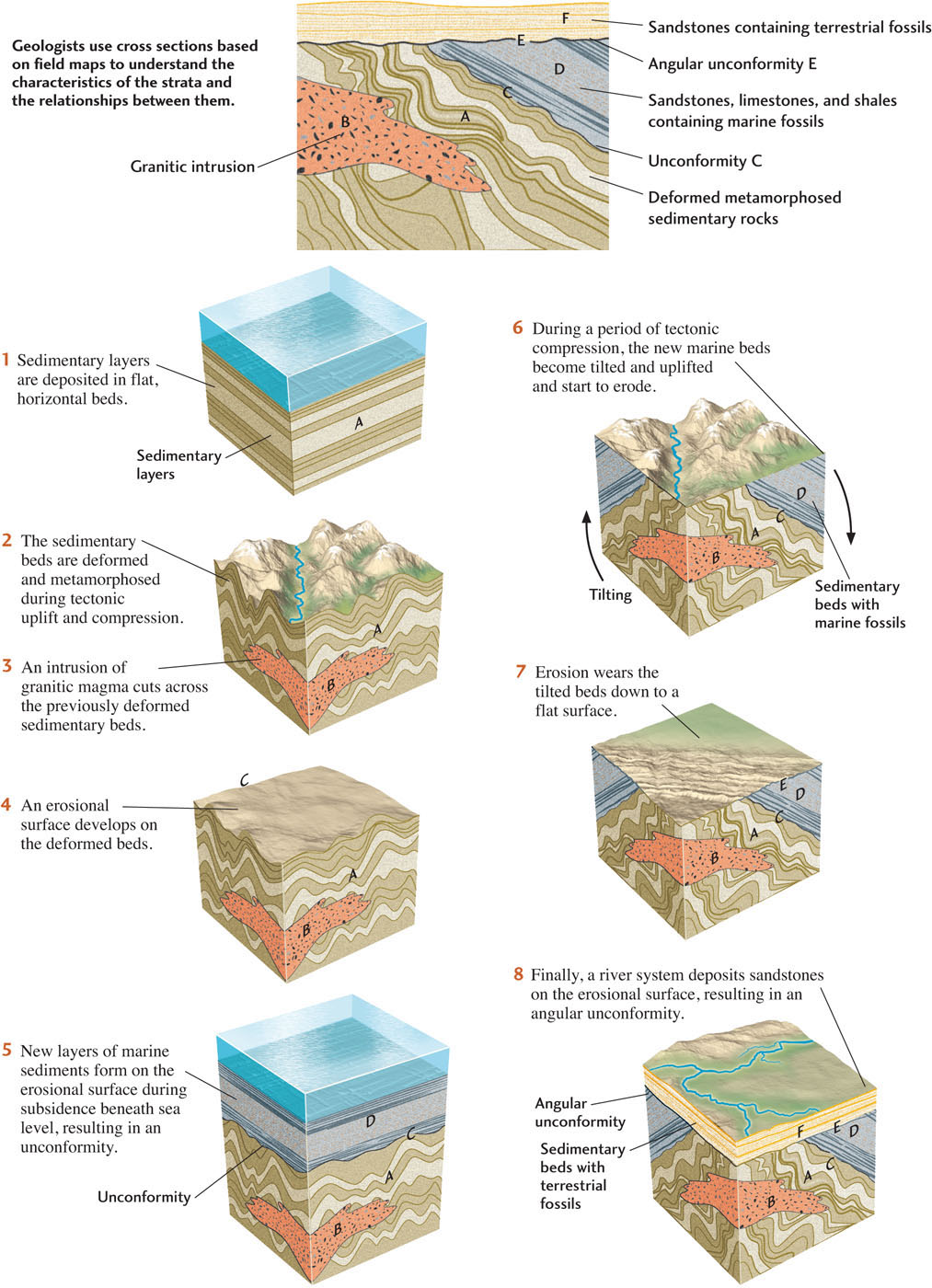Reconstructing Geologic History from the Stratigraphic Record
Geologists speak carefully about time. To them, dating refers not to a popular social activity, but to measuring the absolute age of an event in the geologic record: the number of years elapsed from that event until now. Before the twentieth century, no one knew much about absolute ages; geologists could determine only whether one event was earlier or later than another—their relative ages. They could say, for instance, that fish bones were first deposited in marine sediments before mammal bones first appeared in sediments on land, but they couldn’t tell how many millions of years ago the first fish or mammals appeared.
197
The first geologic observations pertaining to the question of deep time came in the mid-seventeenth century from the study of fossils. A fossil is an artifact of life preserved in the geologic record (Figure 8.2). However, few people living in seventeenth-century Europe would have understood this definition. Most thought that the seashells and other lifelike forms they found in rocks dated from Earth’s beginnings about 6000 years earlier, or grew there spontaneously.
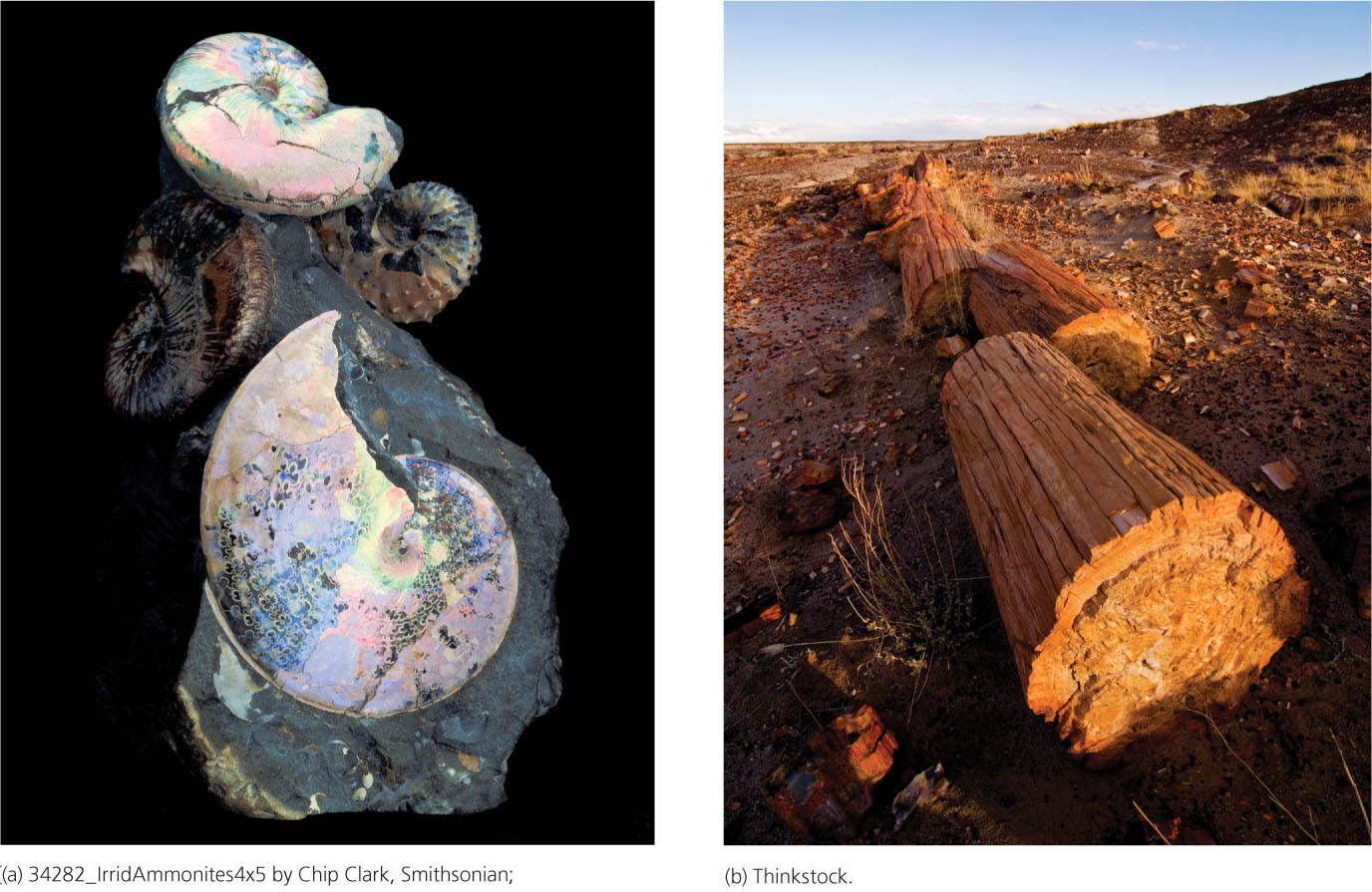
In 1667, the Danish scientist Nicolaus Steno, who was working for the royal court in Florence, Italy, demonstrated that the peculiar “tongue stones” found in certain Mediterranean sedimentary rocks were essentially identical to the teeth of modern sharks (Figure 8.3). He concluded that tongue stones really were ancient shark teeth preserved in the rocks, and more generally, that fossils were the remains of ancient life deposited with sediments. To convince people of his ideas, Steno wrote a short but brilliant book about the geology of Tuscany, in which he laid the foundation for the modern science of stratigraphy—the study of strata (layers) in rocks.
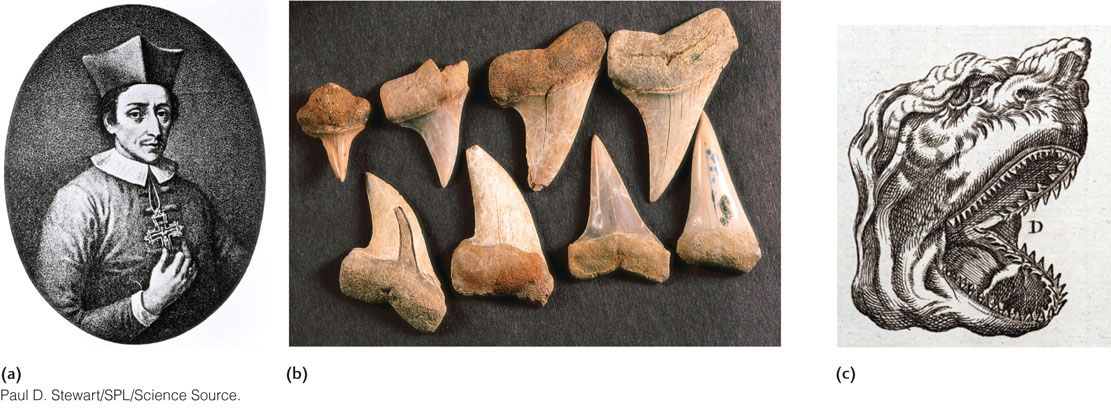
Principles of Stratigraphy
Geologists still use the principles set forth by Steno to interpret sedimentary strata. Two of his basic rules are so simple they seem obvious to us today:
- 1. The principle of original horizontality states that sediments are deposited under the influence of gravity as nearly horizontal beds. Observations in a wide variety of sedimentary environments support this principle. If we find folded or faulted strata, we know that the beds were deformed by tectonic forces after the sediments were deposited.
- 2. The principle of superposition states that each layer of an undeformed sedimentary sequence is younger than the one beneath it and older than the one above it. A new layer cannot be deposited beneath an existing layer. Thus, strata can be vertically ordered in time from the lowest (oldest) bed to the uppermost (youngest) bed (Figure 8.4). A chronologically ordered set of strata is known as a stratigraphic succession.
 Figure 8.4 Steno’s principles guide the study of sedimentary strata. (a) Sediments are deposited in horizontal layers before being slowly transformed into sedimentary rock. If left undisturbed by tectonic processes, the youngest layers remain on the top and the oldest on the bottom. (b) Marble Canyon, part of the Grand Canyon, was cut by the Colorado River through what is now northern Arizona, revealing these undisturbed strata, which record millions of years of geologic history.
Figure 8.4 Steno’s principles guide the study of sedimentary strata. (a) Sediments are deposited in horizontal layers before being slowly transformed into sedimentary rock. If left undisturbed by tectonic processes, the youngest layers remain on the top and the oldest on the bottom. (b) Marble Canyon, part of the Grand Canyon, was cut by the Colorado River through what is now northern Arizona, revealing these undisturbed strata, which record millions of years of geologic history.
198
We can apply Steno’s principles in the field to determine whether one sedimentary formation is older than another. Then, by piecing together the formations exposed in different outcrops, we can sort them into chronological order and thus construct the stratigraphic succession of a region—at least in principle.
In practice, there were two problems with this strategy. First, geologists almost always found gaps in a region’s stratigraphic succession, indicating time intervals that had gone entirely unrecorded. Some of these intervals were short, such as periods of drought between floods; others lasted for millions of years—for example, periods of regional tectonic uplift when thick sequences of sedimentary rocks were removed by erosion. Second, it was difficult to determine the relative ages of two formations that were widely separated in space; stratigraphy alone couldn’t determine whether a sequence of mudstones in, say, Tuscany was older, younger, or the same age as a similar sequence in England. It was necessary to expand Steno’s ideas about the biological origin of fossils to solve these problems.
Fossils as Recorders of Geologic Time
In 1793, William Smith, a surveyor working on the construction of canals in southern England, recognized that fossils could help geologists determine the relative ages of sedimentary rocks. Smith was fascinated by the variety of fossils he collected from the strata exposed along canal cuts. He observed that different layers contained different sets of fossils, and he was able to tell one layer from another by the characteristic fossils in each. He established a general order for the sequence of fossil assemblages and strata, from lowest (oldest) to uppermost (youngest). Regardless of its location, Smith could predict the stratigraphic position of any particular layer or formation in any outcrop in southern England based on its fossil assemblages. This stratigraphic ordering of the fossils of animal species (fauna) produces a sequence known as a faunal succession.
199
Smith’s principle of faunal succession states that the sedimentary strata in an outcrop contain fossils in a definite sequence. The same sequence can be found in outcrops at other locations, so that strata in one location can be matched to strata in another location.
Using faunal successions, Smith was able to identify formations of the same age in different outcrops. By noting the vertical order in which the formations were found in each place, he compiled a composite stratigraphic succession for the entire region. His compilation showed how the complete succession would have looked if the formations at different levels in all the various outcrops could have been brought together at a single spot. Figure 8.5 shows such a composite stratigraphic succession for two outcrops.
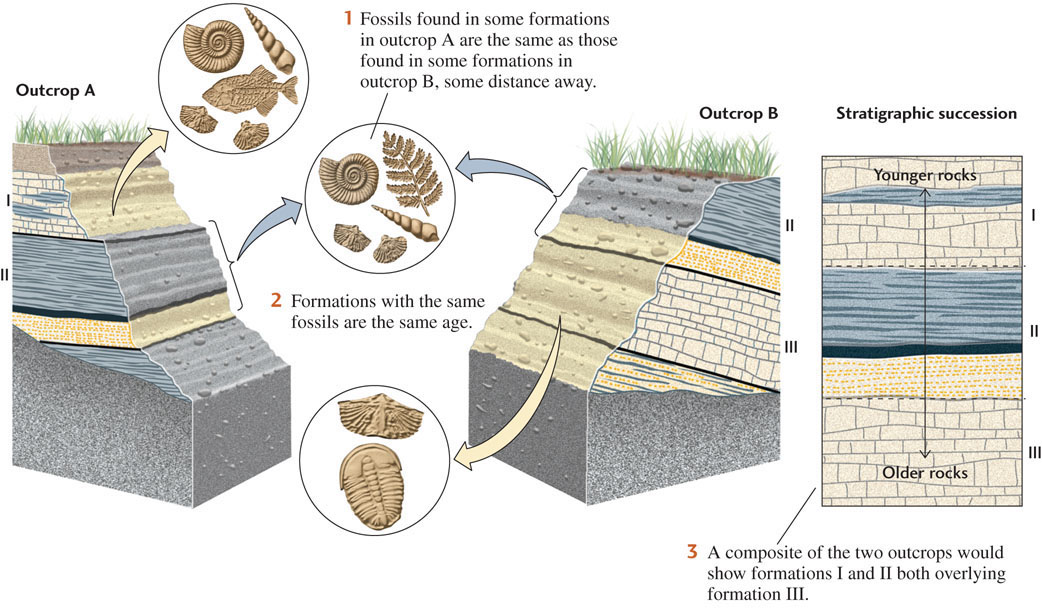
Smith kept track of his work by mapping outcrops using colors assigned to specific formations, thus inventing the geologic map (see Figure 7.4). In 1815, he summarized his lifelong research by publishing his General Map of Strata in England and Wales, a hand-colored masterpiece 8 feet tall and 6 feet wide—the first geologic map of an entire country. The original still hangs in the offices of the Geological Society of London.
The geologists who followed in Steno’s and Smith’s footsteps described and catalogued hundreds of fossils and their relationships to modern organisms, establishing the new science of paleontology: the historical study of ancient life-forms. The most common fossils they found were the shells of invertebrate animals. Some were similar to clams, oysters, and other living shellfish; others represented strange species with no living examples, such as the trilobites shown in the chapter opening photo. Less common were the bones of vertebrates, such as mammals, birds, and the huge extinct reptiles they called dinosaurs. Plant fossils were found to be abundant in some rocks, particularly in coal beds, where leaves, twigs, branches, and even whole tree trunks could be recognized. Fossils were not found in intrusive igneous rocks—no surprise, since any biological material would have been destroyed when the rocks melted—nor in high-grade metamorphic rocks—where any remains of organisms would have been distorted beyond recognition.
By the beginning of the nineteenth century, paleontology had become the single most important source of information about geologic history. The systematic study of fossils affected science far beyond geology, however. Charles Darwin studied paleontology as a young scientist, and he collected many unusual fossils on his famous voyage aboard the Beagle (1831–1836). During this world-circling tour, he also studied many unfamiliar animal and plant species in their native habitats. Darwin pondered what he had seen until 1859, when he proposed his theory of evolution by natural selection. His theory revolutionized the science of biology and provided a sound theoretical framework for paleontology: if organisms evolve progressively over time, then the fossils in each sedimentary bed must represent the organisms living when that bed was deposited.
200
Unconformities: Gaps in the Geologic Record
In compiling the stratigraphic succession of a region, geologists often find places in the geologic record where a formation is missing. Either no rock was ever deposited, or it was eroded away before the next strata were laid down. The surface between two beds that were laid down with a time gap between them—the boundary representing the missing time—is called an unconformity (Figure 8.6). A series of beds bounded above and below by unconformities is referred to as a sedimentary sequence. An unconformity, like a sedimentary sequence, represents the passage of time.
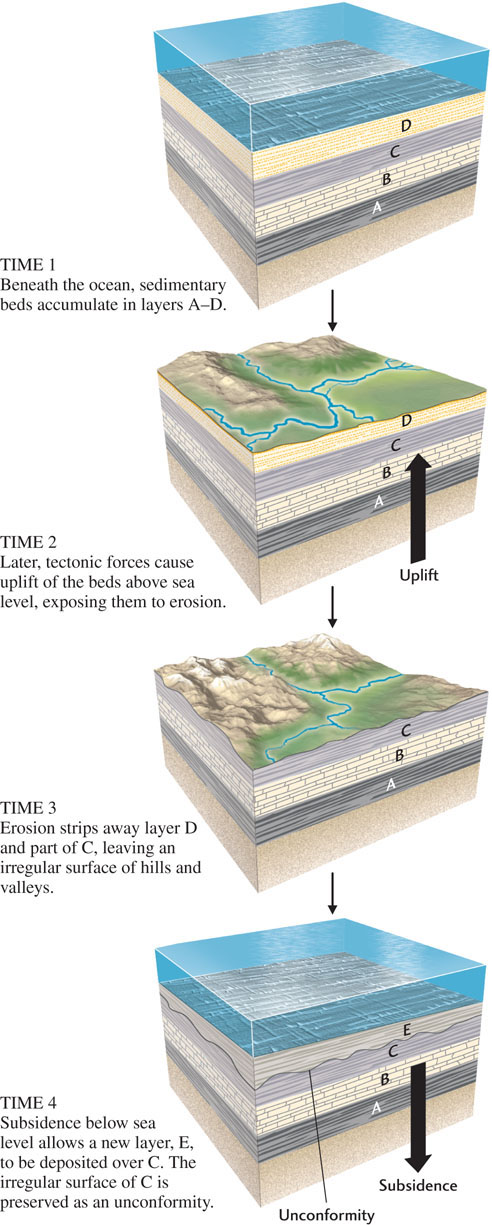
An unconformity may imply that tectonic forces raised the rock above sea level, where erosion removed some rock layers. Alternatively, the unconformity may have been produced by the erosion of newly exposed rock as sea level fell. As we will see in Chapter 21, global sea level can be lowered by hundreds of meters during ice ages, when water is withdrawn from the oceans to form continental ice sheets.
Unconformities are classified according to the relationships between the layers above and below them:
 A disconformity is an unconformity in which an upper sedimentary sequence overlies an erosional surface developed on an undeformed, still-horizontal lower sedimentary sequence (see Figure 8.6). Disconformities are often created when sea level drops or during broad tectonic uplifts.
A disconformity is an unconformity in which an upper sedimentary sequence overlies an erosional surface developed on an undeformed, still-horizontal lower sedimentary sequence (see Figure 8.6). Disconformities are often created when sea level drops or during broad tectonic uplifts. A nonconformity is an unconformity in which the upper sedimentary beds overlie metamorphic or igneous rocks (see Earth Issues 8.1, pages 204–205, for an example).
A nonconformity is an unconformity in which the upper sedimentary beds overlie metamorphic or igneous rocks (see Earth Issues 8.1, pages 204–205, for an example). An angular unconformity is an unconformity in which the upper beds overlie lower beds that have been folded by tectonic processes and then eroded to a more or less even plane. In an angular unconformity, the two sequences have bedding planes that are not parallel. Figure 8.7 depicts a dramatic angular unconformity found near the bottom of the Grand Canyon. The formation of an angular unconformity by tectonic processes is illustrated in Figure 8.8.
An angular unconformity is an unconformity in which the upper beds overlie lower beds that have been folded by tectonic processes and then eroded to a more or less even plane. In an angular unconformity, the two sequences have bedding planes that are not parallel. Figure 8.7 depicts a dramatic angular unconformity found near the bottom of the Grand Canyon. The formation of an angular unconformity by tectonic processes is illustrated in Figure 8.8. Figure 8.7 The Great Unconformity in the Grand Canyon, Arizona, is an angular unconformity between the horizontal Tapeats sandstone above and the steeply dipping Wapatai shale below. The Wapatai shale is part of the Grand Canyon Beds; the Tapeats sandstone formed during the Cambrian Period.
Figure 8.7 The Great Unconformity in the Grand Canyon, Arizona, is an angular unconformity between the horizontal Tapeats sandstone above and the steeply dipping Wapatai shale below. The Wapatai shale is part of the Grand Canyon Beds; the Tapeats sandstone formed during the Cambrian Period.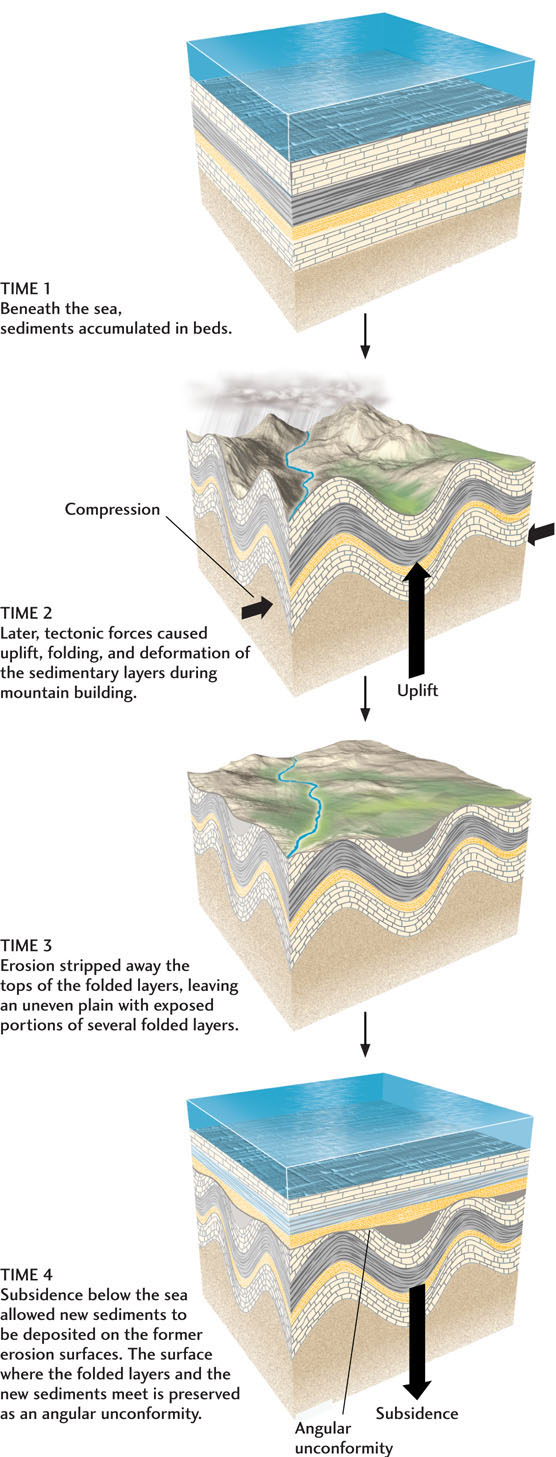 Figure 8.8 An angular unconformity is a surface that separates two sedimentary sequences whose bedding planes are not parallel. This series of drawings shows how an angular unconformity can form.
Figure 8.8 An angular unconformity is a surface that separates two sedimentary sequences whose bedding planes are not parallel. This series of drawings shows how an angular unconformity can form.
201
Cross-Cutting Relationships
Other disturbances of the layering of sedimentary strata also provide clues for determining the relative ages of rocks. Recall that dikes can cut through sedimentary beds; sills can be intruded parallel to bedding planes (see Chapter 4); and faults can displace bedding planes, dikes, and sills as they shift blocks of rock (see Chapter 7). These cross-cutting relationships can be used to establish the relative ages of igneous intrusions or faults within the stratigraphic succession. Because the deformation or intrusion events must have taken place after the affected sedimentary beds were deposited, those structures must be younger than the rocks they cut (Figure 8.9). If the intrusions or fault displacements are eroded and planed off at an unconformity and then overlaid by younger sedimentary beds, we know that those structures are older than the younger strata.
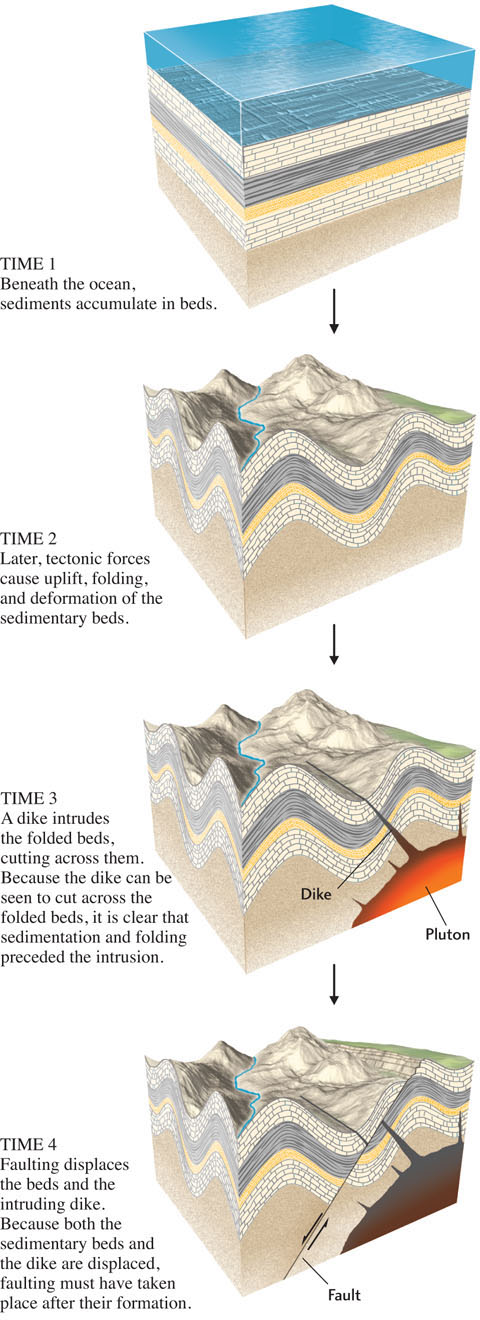
202
Geologists can combine field observations of cross-cutting relationships, unconformities, and stratigraphic successions to decipher the history of geologically complicated regions (Figure 8.10). Earth Issues 8.1 gives a more detailed example of how geologists work backward in time to determine the relative ages of the rocks in a region.
